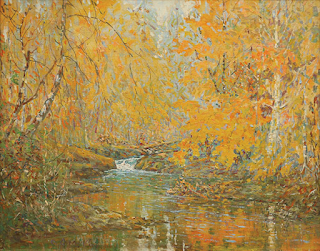By
Alec Clayton
 |
| “Patton Creek," oil on canvas by C.C. McKim, 1924, Tacoma Art Museum, gift of Esther and Jeff Clark, photo by Mark Humpal. |
Well over 100 years later, a majority of the world’s
landscape painters still paint in an Impressionist style. As if landscape art
has not advanced — which it has — since the
1880s.
The
French Impressionists — Renoir, Degas and
their contemporaries — were considered radical when they were
painting. Their art flew in the face of everything that had been considered
sacrosanct in art since the Renaissance 400 years earlier. They dared to paint
common people and commonplace scenes, and didn’t even pretend to hide their brushstrokes.
The establishment considered their art to be crude and childlike and definitely
not museum-worthy.
Tacoma
Art Museum offers a fresh look at the French Impressionists and at American
Impressionists from right here in the Pacific Northwest who were inspired by
the French movement.
The
show is Monet, Renoir, Degas, and Their
Circle: French Impressionism and the Northwest. Drawing on TAM’s own
collection and collections from other museums in the region, it chronologically
covers the development of their art from works by Impressionism’s precursors, such as Jean-Baptiste-Camille
Corot and Gustave Courbet, to masters such as Monet, Degas, Mary Cassatt and
Berthe Morisot, to American Impressionists including C.C. McKim, Clara Jane
Stephens and Fokko Tadama.
“The
purpose of this exhibition is deeply connected to the same passion that drove
the French Impressionists, to transform the way we see,” said TAM executive
director, co-curator of this show along with Margaret Bullock.
In
some of the earliest works, such as Eugène Boudin’s “The Beach at Trouville” we
see that beyond painting commonplace scenes, the important innovations were
lightening the palette and painting with dabs of color not meticulously blended
as was required
in previous work. In Boudin’s “Washerwomen
at Trouville” we see small figures in vast landscapes rendered as simple globs
of paint with no details whatsoever, yet easily readable as people due to
positions, gestures and color.
In
works by Renoir and Monet, we see significant brightening of the palette and
lush laying-on of paint, and
with Sisley and Pissarro paint application becomes dots and dabs of color with
no blending. The rosy cheeks in Renoir’s “Heads of Two Young Girls,” which has
been shown often at TAM, fairly glow, and
the background colors are laid down with exuberant splashes of color.
Many
of the Impressionists severely cropped images as in as in Edgar Degas’
“Dancers,” painted on fan-shaped silk, while others began to paint in more
sketchy manners, the most radical of which, in this show, is Berthe Marisot’s
“Jeanne with Doll,” which looks like it could have been painted in the 21st
century because it is so loose and expressive with more concern with visual
expression than with realistic rendering.
The
American Impressionists of the Pacific Northwest are shown in a separate area
of the gallery. None are particularly well known. They clearly mastered the
Impressionist style, but were a little late arriving on that particular scene.
Since seeing the latest European art without a time delay was almost impossible
in the 19th century, most of them lagged behind the French artists,
painting in the Impressionist style at a time when Picasso and Braque and Kandinsky were
creating abstract art.
Monet, Renoir, Degas, and Their
Circle, 10 a.m. to 5 p.m., Tuesday-Sunday, through Jan. 5, 2020, $12-$55,
Tacoma Art Museum, 1701 Pacific Avenue, Tacoma, 253.272.4258,
www.tacomaartmuseum.org.

No comments:
Post a Comment